Hi all, I'm doing some research for future campaigns and I am having some trouble understanding the difference between fey and elf, and where the Seelie/Unseelie courts fall in with the elven pantheon.
They are very different, as Aralia pointed out. Elves are a race of humanoids that exist in most D&D worlds. Fey are a creature type, in most D&D worlds originating in the Feywild. Elves do have some feyish blood, as shown in their Fey Ancestry trait, but the vast majority of elves are not fey (some are, like some eladrin, but the majority are not).
Elves in D&D were inspired by the elves of Lord of the Rings and the other works of J. R. R. Tolkein, which were inspired by the elves of Norse mythology. There are many different types of elves, such as High Elves, Wood Elves, Dark Elves, Sea Elves, Pallid Elves, Shadar-Kai, Eladrin, and other types of elves, but most of them share many characteristics with Tolken's elves, such as long lives, pointy ears, nimble bodies, and so on.
Fey are different, a category of beings, unlike elves who are a race of people. Fey vary in appearance, having humanoid-looking fey, like the Satyr: Dryads: And quicklings: However, the fey creature type also includes more monstrous looking fey creatures, like the Meenlock: Madcap: And the Screaming Devilkin: They most often can be found in the Feywild and forests, and most of them are split into two different categories, the Seelie and Unseelie fey.
The Seelie Court is filled with fey that embody the more bright and positive emotions, while not being "good". Most fey aren't good or bad, but instead are just pure embodiments of emotions. Too much of any emotion can be deadly, thus why most fey are dangerous. An annis hag embodies pure ugliness and disgust, while a naiad embodies the unrelenting chaos of the ocean. Both can (and will) kill you, they just embody different emotions and concepts.
The elven pantheon (also known as the Seldarine) has an alliance with the Seelie Court, but none of the elven deities are a member of the Seelie Court or vice versa. They just happen to share similar agendas, wishing for freedom and beauty to be spread across the worlds that D&D takes place it.
Just like in real world mythology (and you can find the Seelie Court in real world myths, too), elves are sometimes included under the fey umbrella (as are faeries and other "fey" creatures), as they are often considered a type of fey. Fey are usually found in the Feywild, whereas elves are found on the Prime Material, and resemble elves, but with more aggerated features. Third_Sundering summed up the differences pretty well, so I won't rehash them too much. Elves are humanoids, and have long lives, an affinity to nature, and worship the Seldarine (though I believe the fey do, as well). Think Lord of the Rings.
if we stuck D&D into our classification system...humanoids and fey would probably be two types of Order or Class. Sprites and elves would probably be two types of Species (which D&D calls Race). - the two systems don't really line up though.
keep in mind that elves are from the Feywild, but not really fey. In about the year 27,000 BDR (before Dale Reckoning):
Continuing their work to undermine dragon rule, the Fey open new gates allowing the first elves to immigrate to Toril. These primitive green elves worship the Faerie gods (not the Seldarine, which were unknown at this time). Although most green elves are content to remain in small scattered tribes, one group known as the Ilythiiri negotiates with the dragons and begins to carve out a small kingdom in the south. The great Ilythiiri capital at Atorrnash remains a shining beacon of elf culture for millennia.
Then about 1,600 years later:
Fleeing the destruction of the island kingdom of Tintageer on their home world of Faerie, a small circle of gold elves led by the young prince Durothil cast a divination to find their new home—on the world of Toril—and then create a portal leading there. The refugees name their new home Faerûn, the One Land. Integrating into the native green elf communities, the descendants of the gold elves of Tintageer become known as sun elves, while the descendants of the sole silver elf refugee, Sharlario Moonflower, become known as moon elves.
Great topic. No expert on lore having dropped away from DND play till recently(since ADD) but it seems there were too many cooks in the kitchen concerning the lore. I believe Chris Perkins talks about the topic in a Dragon Talks. Regarding the Courts, my table is a fan of the Dresden Files by Jim Butcher and we flavor them along his lines.
Rollback Post to RevisionRollBack
To post a comment, please login or register a new account.
Hi all, I'm doing some research for future campaigns and I am having some trouble understanding the difference between fey and elf, and where the Seelie/Unseelie courts fall in with the elven pantheon.
elf have a bit of fey blood in them but the two are very different
I am leader of the yep cult:https://www.dndbeyond.com/forums/off-topic/adohands-kitchen/82135-yep-cult Pronouns are she/her
They are very different, as Aralia pointed out. Elves are a race of humanoids that exist in most D&D worlds. Fey are a creature type, in most D&D worlds originating in the Feywild. Elves do have some feyish blood, as shown in their Fey Ancestry trait, but the vast majority of elves are not fey (some are, like some eladrin, but the majority are not).
Elves in D&D were inspired by the elves of Lord of the Rings and the other works of J. R. R. Tolkein, which were inspired by the elves of Norse mythology. There are many different types of elves, such as High Elves, Wood Elves, Dark Elves, Sea Elves, Pallid Elves, Shadar-Kai, Eladrin, and other types of elves, but most of them share many characteristics with Tolken's elves, such as long lives, pointy ears, nimble bodies, and so on.
Fey are different, a category of beings, unlike elves who are a race of people. Fey vary in appearance, having humanoid-looking fey, like the Satyr: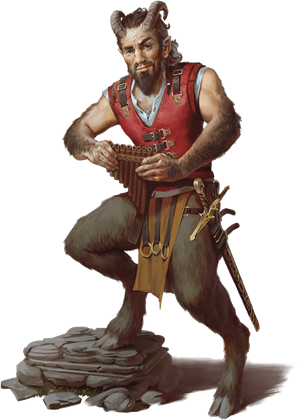 Dryads:
Dryads: 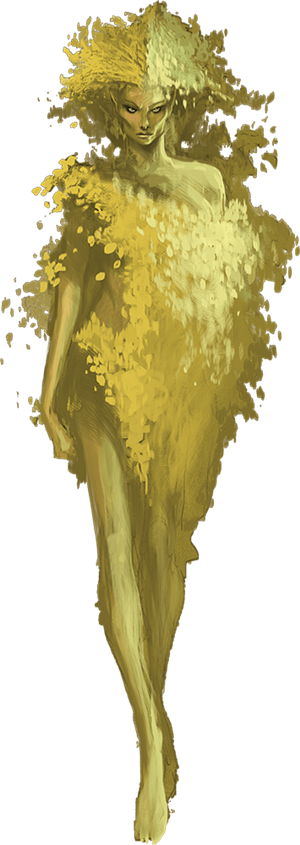 And quicklings:
And quicklings: 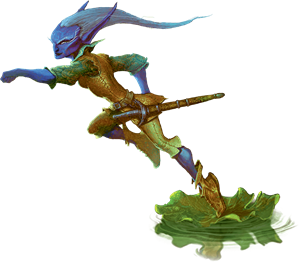 However, the fey creature type also includes more monstrous looking fey creatures, like the Meenlock:
However, the fey creature type also includes more monstrous looking fey creatures, like the Meenlock: 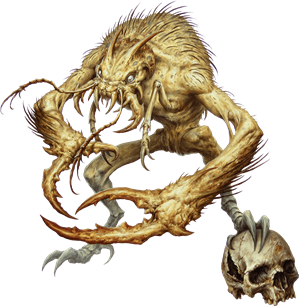 Madcap:
Madcap:  And the Screaming Devilkin:
And the Screaming Devilkin: 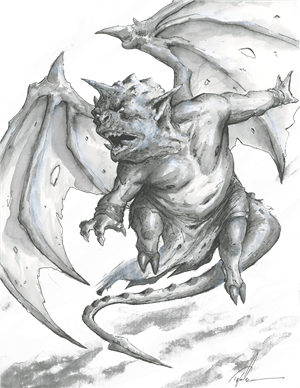 They most often can be found in the Feywild and forests, and most of them are split into two different categories, the Seelie and Unseelie fey.
They most often can be found in the Feywild and forests, and most of them are split into two different categories, the Seelie and Unseelie fey.
The Seelie Court is filled with fey that embody the more bright and positive emotions, while not being "good". Most fey aren't good or bad, but instead are just pure embodiments of emotions. Too much of any emotion can be deadly, thus why most fey are dangerous. An annis hag embodies pure ugliness and disgust, while a naiad embodies the unrelenting chaos of the ocean. Both can (and will) kill you, they just embody different emotions and concepts.
The elven pantheon (also known as the Seldarine) has an alliance with the Seelie Court, but none of the elven deities are a member of the Seelie Court or vice versa. They just happen to share similar agendas, wishing for freedom and beauty to be spread across the worlds that D&D takes place it.
Does this help? Any other questions?
Please check out my homebrew, I would appreciate feedback:
Spells, Monsters, Subclasses, Races, Arcknight Class, Occultist Class, World, Enigmatic Esoterica forms
Just like in real world mythology (and you can find the Seelie Court in real world myths, too), elves are sometimes included under the fey umbrella (as are faeries and other "fey" creatures), as they are often considered a type of fey. Fey are usually found in the Feywild, whereas elves are found on the Prime Material, and resemble elves, but with more aggerated features. Third_Sundering summed up the differences pretty well, so I won't rehash them too much. Elves are humanoids, and have long lives, an affinity to nature, and worship the Seldarine (though I believe the fey do, as well). Think Lord of the Rings.
This may help, too: https://forgottenrealms.fandom.com/wiki/Elf
https://forgottenrealms.fandom.com/wiki/Fey
if we stuck D&D into our classification system...humanoids and fey would probably be two types of Order or Class. Sprites and elves would probably be two types of Species (which D&D calls Race). - the two systems don't really line up though.
keep in mind that elves are from the Feywild, but not really fey. In about the year 27,000 BDR (before Dale Reckoning):
Continuing their work to undermine dragon rule, the Fey open new gates allowing the first elves to immigrate to Toril. These primitive green elves worship the Faerie gods (not the Seldarine, which were unknown at this time). Although most green elves are content to remain in small scattered tribes, one group known as the Ilythiiri negotiates with the dragons and begins to carve out a small kingdom in the south. The great Ilythiiri capital at Atorrnash remains a shining beacon of elf culture for millennia.
Then about 1,600 years later:
Fleeing the destruction of the island kingdom of Tintageer on their home world of Faerie, a small circle of gold elves led by the young prince Durothil cast a divination to find their new home—on the world of Toril—and then create a portal leading there. The refugees name their new home Faerûn, the One Land. Integrating into the native green elf communities, the descendants of the gold elves of Tintageer become known as sun elves, while the descendants of the sole silver elf refugee, Sharlario Moonflower, become known as moon elves.
Guide to the Five Factions (PWYW)
Deck of Decks
Great topic. No expert on lore having dropped away from DND play till recently(since ADD) but it seems there were too many cooks in the kitchen concerning the lore. I believe Chris Perkins talks about the topic in a Dragon Talks.
Regarding the Courts, my table is a fan of the Dresden Files by Jim Butcher and we flavor them along his lines.